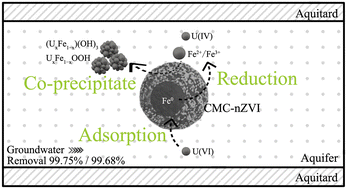Preparation of carboxy methyl cellulose stabilized nano-sized zero-valent iron and its properties for in situ remediation of groundwater in areas after acid in situ leach uranium mining
Abstract
Dissolved uranium in groundwater contaminated by acid in situ leaching poses a serious threat to human health and the ecosystem due to its toxicological properties. In this article, carboxy methyl cellulose (CMC) with high dispersity was used to stabilize nano zero-valent iron (nZVI), and highly dispersed CMC-stabilized nZVI (CMC-nZVI) was synthesized by a liquid-phase reduction method, characterized by multiple analysis techniques, and tested for its dispersal and antioxidizing properties. Compared with nZVI, CMC-nZVI showed great dispersal and resistance to oxidation. The effects of oxygen, pH, dosage, initial U(VI) concentration and HA concentration on U(VI) elimination by CMC-nZVI, and the U(VI) removal kinetics and mechanism were investigated. The removal capacity of U(VI) by CMC-nZVI was 400 mg g−1 at pH 3.0, and the dose of 0.1 g L−1 showed excellent uranium removal efficiency under acid conditions. Moreover, CMC-nZVI was used to treat groundwater from an area after acid in situ leach uranium mining, and CMC-nZVI was found to be capable of decreasing the concentration of uranium in the acidic groundwater (pH < 3) from 0.321 to 0.001 mg L−1. The results indicate that CMC-nZVI has potential application prospects in the in situ remediation of groundwater in areas after acid in situ leach uranium mining.



 Please wait while we load your content...
Please wait while we load your content...